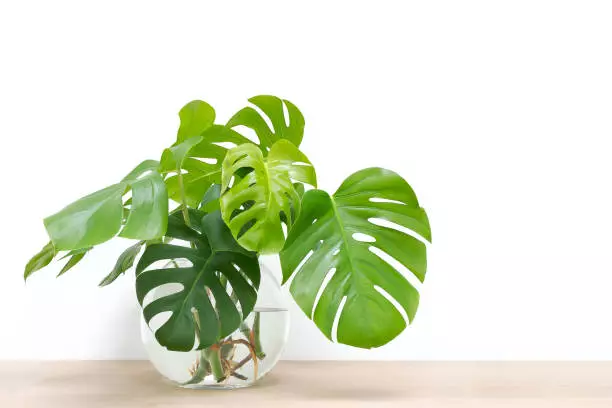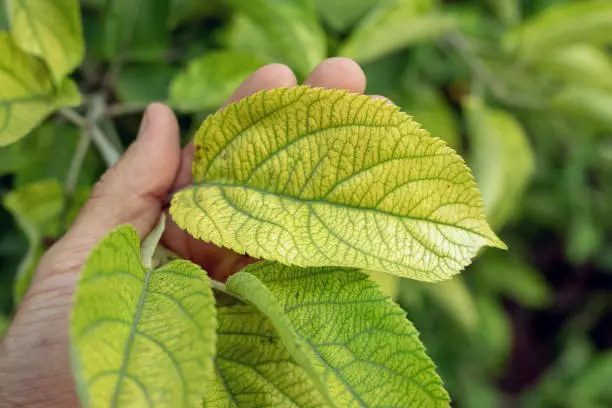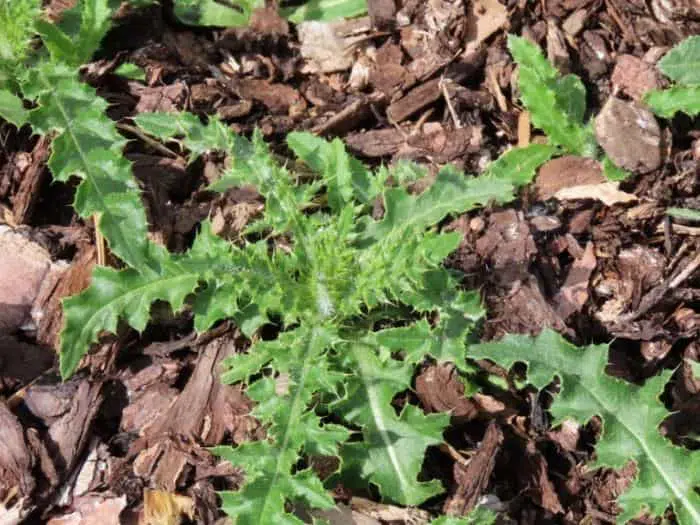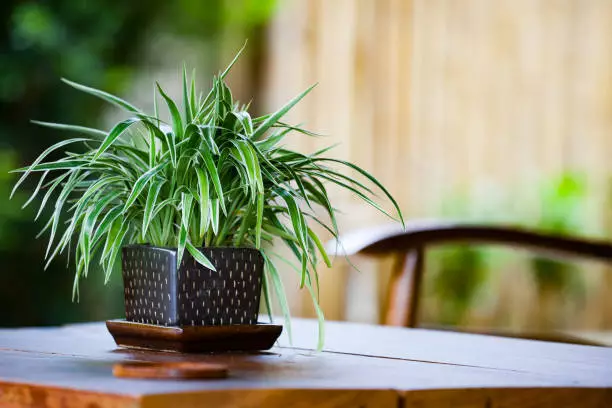Spider plants are easy and pleasant to grow especially in hanging baskets because of their trailing growth behavior. One major sign that there’s a problem is when leaves start to turn brown at the tips and edges. But why are the tips of your spider plant turning brown?
Brown spider plant tips are a sign of overwatering, underwatering, fungal disease, or fertilizer burn. Move the plant to a shaded place and remove it from the pot. Cut off the brown tips, treat root rot then repot with a fresh potting mix to fix the brown tips. Water lightly until the plant revives.
If the brown-black leaf tips are caused by excess fertilizer or chlorine in the soil, flush out the excess chlorine and fluoride salts to stop the spider plant from turning brown.
Why does my spider plant have brown tips?
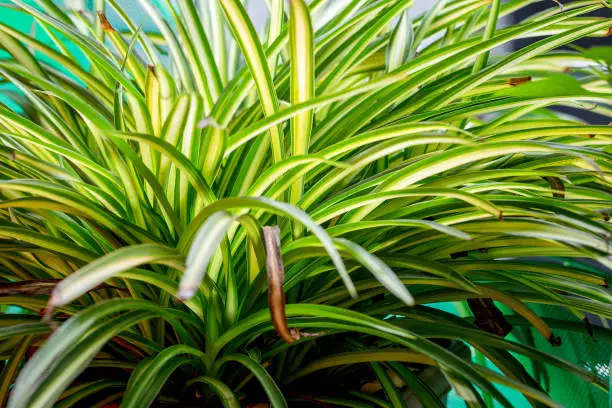
Many reasons can cause indoor plants such as spider plants to turn brown or black at the tips or edges of leaves.
Brown tips on spider plants are caused by the salt burn that occurs if you water the plant with tap water. Dry soil (underwatering) and low humidity can also make the leaves turn brown on the edges.
Here’s a summary of the causes of brown leaf tips on a spider plant.
| Cause | Fix for brown tips |
| Watering problems | Allow soil to dry out between waterings. |
| Excessive salts in the soil | Flush out salts by pouring and draining water in the pot several times. |
| Overexposure to sunlight | Move the plant to a spot with preferred bright indirect light. |
| Low humidity | Mist the plant or run a humidifier in the room to fix dry air problems. |
| Plant diseases | Treat bacterial leaf blight soon enough to stop brown leaf tips. |
| Constricted roots | Repot the spider plant in a larger pot to allow room for roots. |
RELATED: WHAT IS INDIRECT LIGHT FOR PLANTS
Causes and fixes for brown tips on spider plant leaves
1. Stress from over-watering
Browning leaves could occur because of water stress. This can happen when you either under or overwater your plant.
An overwatered spider plant will soon develop root rot disease. The roots of the plant will begin to rot as the excess water will hinder the aeration in the roots. This will hinder the flow of nutrients and water to the rest of the plant and the leaves will start to turn brown. If you do not fix the problem immediately, there is a high chance that the plant may die.
Spider plants usually do well in soil that does not dry out completely, so when you under-water the plant; the leaves gradually dry out. This then makes them turn brown.
RELATED: HOW TO REVIVE OVERWATERED SPIDER PLANT
2. Salt build-up in the soil
Another cause for leaf browning is salt build-up from fertilizers. When you apply too much fertilizer to your plant, it will cause plant toxicity and destroy its roots. This will then make the leaves’ tips turn brown.
3. Chrolorine + Fluoride salts
Many times, the browning tips on your spider plant might be because you subjected them to too much water that has high fluoride and chlorine content. This occurs when you water spider plants with tap water.
Fluoride build-up will mess with the plant’s health when it is in high quantity as it inhibits numerous plants’ natural processes. One such process is photosynthesis.
High fluoride content in water used to water plants alsodestroysf the plant’s tissues. Because of such things, you may find your spider plant’s leaves turning brown.
4. Overexposure to sunlight
Spider plants dislike the hot scorching sun as it causes the soil that they are planted in to dry up completely. As a result, no moisture is left in the ground. If the plant lacks enough moisture, the leaves will start turning brown at the tips and curling.
Another reason why spider plants do not do well in direct sunlight is that it burns the leaves and turns them brown, yellow, or black.
5. Diseases
Bacterial leaf blight might be the reason why your spider plant leaves are discoloring. It usually starts as light spots at the tip of the leaves, which then gradually turn to brown.
If the leaves of your spider plant turn brown to black, it is a sure sign of bacterial leaf spot disease. It occurs when the room is too hot and too humid. Remove the damaged leaves and stop watering the plant from above.
6. Constricted roots
This is common in potted plants where the container in which they are grown is too small for the roots.
It can also happen to plants that are grown on the grounds too, mainly those which have been planted in heavy clay soils. This then makes the spider plants have brown tips.
7. Low humidity
For the spider plant to thrive, it needs high humidity levels. In areas with low humidity, the leaves dry out, and the tips start turning brown.
Should I cut brown tips off spider plants?
Yes! You should cut the leaves that have turned brown, especially those that have been plagued by diseases. Doing so goes a long way in saving your plant from death.
Pro tip: Use garden scissors or pruning shears to do the job perfectly. Remember to sterilize your garden scissors or pruning shears using alcohol or any other available sterilizer. This reduces the risk of spreading diseases from one plant to another.
How to stop the leaves from turning brown?
The first thing to do to keep a spider plant healthy is to grow it in bright indirect light, allow the soil to dry out between irrigations, and maintain medium-level humidity in the house. Treat any diseases and pests to prevent leaf discoloration.
Apart from growing the plants in their ideal conditions, there’s a lot you can do to fix brown tips on spider plants.
Here’s how:
1. Cut the affected areas
If the reason for brown tips on leaves is overwatering, you will find that the roots would have rotted extensively. Make sure you cut the affected roots to give your plant a fighting chance.
To prevent the problem of overwatering, make sure you use well-drained soil and a pot with an excellent drainage system. You may need to replace the soil with new potting soil to stop the spider plant leaves from turning brown at the tips.
RELATED: HOW LONG DOES IT LAST FOR POTTING SOIL TO BECOME BAD AND EXPIRE
2. Water properly
If the problem was under-watering, you can evaluate the soil in the pot and assess the moisture level in the container, then ensure you water the plant frequently.
You are probably wondering how to water your plant correctly. Well, this should not worry you anymore. All you have to do is put your index finger into the soil of the spider plant. If the first two inches of your finger is dry, that’s a clear indicator that your plant needs watering!
During the first year of growing the spider plant, you should water after every seven days to keep the soil moist, but never wet. But after the first year, you can water it whenever the soil is dry.
Avoid watering the plant using the overhead method.
If the problem with your spider plant is a disease, you should avoid watering the plant using the overhead method. You should also discard all damaged foliage.
Unfortunately, if the disease has affected the stems, you will have to get rid of your plant as it will die. If you don’t dispose of it, you might risk it infecting your other houseplants, and I assume you don’t want that to happen.
3. Apply less fertilizer
If the problem was that you applied too much fertilizer that salts began to accumulate. You can fix the problem by changing the plant’s pot with fresh soil.
Another option is to stop applying fertilizer to your plant and flushing the soil with distilled water to get rid of excess salt, which accumulated in the roots.
Note: During the growing season, a spider plant needs only to be fertilized once every three months. You may use a water-soluble fertilizer, which is diluted and balanced to feed your plant. Always ensure that you do not go overboard with the fertilizer!
4. Use fluoride-free water
If the problem was high fluoride content in water, you need to make sure that the water you are using to water your plants does not have fluoride in it.
In case you suspect that the browning of the leaves is because of fluoride, flush the soil with distilled water regularly.
How to flush the soil with high fluoride content
- In the spider plant pot, pour a few bottles of water.
- Wait for the water to drain out.
- Once the water has drained out, flush and drain it repeatedly.
Rainwater is the most recommended water to flush the soil.
5. Put your plant under a shade
If the problem was excess sun exposure, ensure that you place your spider plant in a shaded area where it will receive moderate light, that is, if it is grown outside.
If it is grown indoors, place your spider plant in a spot where it will get access to indirect or filtered sunlight.
6. Repot the plant
If the problem was constricted roots, you should replace the small pot with a bigger pot (repot) to give more room for the roots to grow.
It is recommended by experts to repot your spider plants yearly, as they grow quiet.
The process of repotting a spider plant is quite easy. Here is what you need to do;
- Gently remove the plant from the pot it is currently grown.
- Trim and flush the roots.
- Transfer it to a larger pot.
Before you change the pots, ensure that the new pots have good drainage holes simply because spider plants don’t do well in wet soil for a long time.
7. Improve room humidity
If you discover the problem was low humidity. During the winter season, ensure you put your pot with the spider plant in a room where the humidity is high. But when the summer season arrives, you could maintain the high humidity levels by either using a humidity tray or by ensuring timely watering.
Pro tip: To give your spider plant a humidity boost, you can place your plant in the bathroom when you are taking a hot shower!
Spider plants are beautiful house plants loved by many across the globe. They are not only a showpiece, but also have air purification abilities. Now that is why you should take good care of it. Part of the care includes stopping brown tips from forming on the plant’s leaves.
If you adhere to the tips provided above, there is no reason why your plant’s leaves should not remain healthy.
References + Resources:
[1] Karen Russ and Al Pertuit, Ph.D., Clemson University Home, and Garden Information Center: Spider Plant – Watering and Fertilizer
[2] Dr. Leonard Perry, Horticulture Professor Emeritus, University of Vermont: Easy Houseplants – Spider Plant Fertilizer Problems
[3] Colorado State University Extension: Plant Talk – Spider Plant Care
